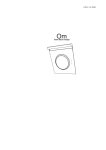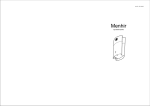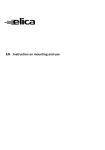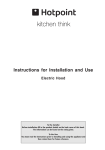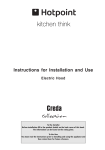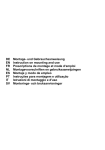Download Mini Om
Transcript
LI2WRA Mini Om Design Lorenzo Lispi 6 CLICK! 3 5 2 1 4 1 2 3 4 F Ø 150mm B 11A 11F B 4 4 (5x18) 10 6 (5x18) 5 6 5 3 7 8 2 9 1 5 INSTRUCTION ON MOUNTING AND USE GB Description of the hood - Fig. 1 1 2 3 4 5 6 7 Control panel Grease filter Grease filter release handle Halogen lamp Vapour screen Air outlet Telescopic flue (optional) Operation Description of control panel and hood operation coupling, accompany it upward. Closing the steam screen: Accompany the steam screen downwards, press firmly and check the resulting coupling. Grease filter This must be cleaned once a month using non aggressive detergents, either by hand or in the dish-washer, which must be set to a low temperature and a short cycle. When washed in a dish-washer, the grease filter may discolour slightly, but this does not affect its filtering capacity. Removing the grease filters - Fig. 2 Open the steam screen. Pull the handle downwards and extract the filter. Charcoal filter (filter version only) D C B A A. on/off light switch B. on/off aspiration switch and minimum power selection B+C. medium power selection aspiration switch B+D. maximum power selection aspiration switch Use the high suction speed in cases of concentrated kitchen vapours. It is recommended that the cooker hood suction is switched on for 5 minutes prior to cooking and to leave in operation during cooking and for another 15 minutes approximately after terminating cooking. Maintenance Prior to any maintenance operation ensure that the cooker hood is disconnected from the power supply. Cleaning The cooker hood should be cleaned regularly internally and externally. For cleaning use a cloth moistened with denatured alcohol or neutral liquid detergents. Avoid abrasive detergents. Warning: Failure to carry out the basic standards of the cleaning of the cooker hood and replacement of the filters may cause fire risks. Therefore we recommend oserving these instructions. Steam screen The steam screen must always be left closed and opened only for maintenance (e.g. cleaning or changing filters). Opening the steam screen: Press the lower part of the steam screen firmly. After It absorbs unpleasant odours caused by cooking. The charcoal filter can be washed once every two months using hot water and a suitable detergent, or in a dish-washer at 65°C (if the dish-washer is used, select the full cycle function and leave dishes out). Eliminate excess water without damaging the filter, then remove the mattress located inside the plastic frame and put it in the oven for 10 minutes at 100° C to dry completely. Replace the mattress every 3 years and when the cloth is damaged. • Montage - Fig. 3 Open the steam screen and remove the grease filter. Install the carbon filter on the back of the grease filter and fix with two rods. Attention! The rods are included in the carbon filter packing and not on the hood. • To dismantle the filter act in the reverse manner. Replacing lamps - Fig. 4 Firstly check that the lamps are well cooled prior to replacing them. Access the light compartment – extract the guard by levering it off with a small screwdriver or similar tool. Replace the damaged light bulb. Only use halogen bulbs of 20W max (G4), making sure you do not touch them with your hands. Close the lamp cover (it will snap shut). If the lights do not work, make sure that the lamps are fitted properly into their housings before you call for technical assistance. Caution This appliance is designed to be operated by adults. Children should not be allowed to tamper with the controls or play with the appliance. Do not use the cooker hood where the grill is not correctly fixed! The suctioned air must not be conveyed in the same channel used for fumes discharged by appliances powered by other than electricity. The environment must always be adequately aerated when the cooker hood and other 8 INSTRUCTION ON MOUNTING AND USE GB appliances powered by other than electricity are used at the same time. Flambé cooking with a cooker hood is prohibited. The use of a free flame is damaging to the filters and may cause fire accidents, therefore free flame cooking must be avoided. Frying of foods must be kept under close control in order to avoid overheated oil catching fire. Carry out fumes discharging in accordance with the regulations in force by local laws for safety and technical restrictions. Installation - Fig. 5 Consult the designs in the front pages referenced in the text by alphabet letters. Closely follow the instructions set out in this manual. All responsibility, for any eventual inconveniences, damagxes or fires caused by not complying with the instructions in this manual, is declined. The hood must be at a distance of not less than 40 cm from the cooking top with electric plates. If the instructions for installation for the gas hob specify a greater distance, this must be adhered to. The hood is supplied in the FILTERING version and is used without an extracted fumes discharger conduit . Fumes and steam are recycled through the F deflector (11F). If you intend using the product in the SUCTION version, it is necessary to have an evacuation conduit going from the upper B exit to the extraction hole towards the exterior. In this case a connection ring (11A) has to be installed on the B extraction hole and the carbon filter removed. A telescopic flue is available (as an accessory). Preliminary information for installation of the hood Expansion wall plugs are provided to secure the hood to most types of walls/ceilings. However, a qualified technician must verify suitability of the materials in accordance with the type of wall/ceiling. The wall/ceiling must be strong enough to take the weight of the hood. Do not tile, grout or silicone this appliance to the wall. Surface mounting only. In the case of the presence of panels and/or walls and/or lateral wall units check that there is sufficient space to install the hood and that access to the command panel is easy. Only for some models An aesthetic flue can be purchased as an optional accessory. Check with the assistance centre whether the model in your possession envisages this possibility. We advise installing the hood after having purchased the flue to check with certainty the most suitable installation. During electrical connection ensure the power supply is disconnected at the domestic main switch. • Trace a centre line on the wall to facilitate the montage (1), position the hole template so that the middle line printed on it corresponds to the centre line previously drawn and that the lower side of the grill corresponds to the lower part of the hood once mounted (2). • Make two holes with the 8 mm Ø drill and fix the support bracket with two dowels and wall screws (3). • • • • • Open the steam screen and remove the grease filter (see relative paragraph). Hang up the hood (4), adjust its position (5-6) and mark 1 point from the inside of the hood for the definitive fixing (7). Remove the hood and make a Ø 8 mm hole with the drill (8), insert the wall dowel and hang the hood up again and fix it definitively with 1 screw (9). Connect the electricity (10), but leave the hood disconnected from the general electric panel of the house. Install the supplied flange (11A –suction version– also install a discharge tube of suitable dimensions) or the deflector (11F – filtering version). Mount the grease filter and close the steam screen. Attention! If the hood is to be used in the suction version, remove, if supplied with the kit, the carbon filter and the fixing rods (on the back of the grease filter – see relative paragraph). If the hood is to be used in the filtering version, check that the carbon filter is already mounted on the back of the grease filter or, in its absence, purchase it and install it. Electrical connection The electrical tension must correspond to the tension noted on the label placed inside the cooker hood. Connect the electrical plug, where provided, to the an easily accessible outlet in conformity with local standards in force. Where an electrical plug is not provided (for direct connection to electrical network) place a standards approved bipolar switch with an aperture distance of not less than 3mm (accessible) from the contacts. This appliance is marked according to the European directive 2002/96/EC on Waste Electrical and Electronic Equipment (WEEE). By ensuring this product is disposed of correctly, you will help prevent potential negative consequences for the environment and human health, which could otherwise be caused by inappropriate waste handling of this product. on the product, or on the documents The symbol accompanying the product, indicates that this appliance may not be treated as household waste. Instead it shall be handed over to the applicable collection point for the recycling of electrical and electronic equipment. Disposal must be carried out in accordance with local environmental regulations for waste disposal. For more detailed information about treatment, recovery and recycling of this product, please contact your local city office, your household waste disposal service or the shop where you purchased the product.







